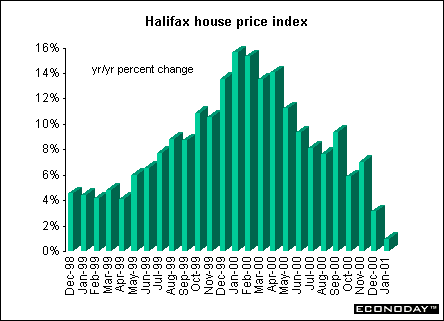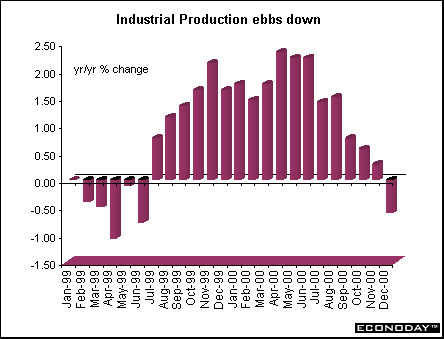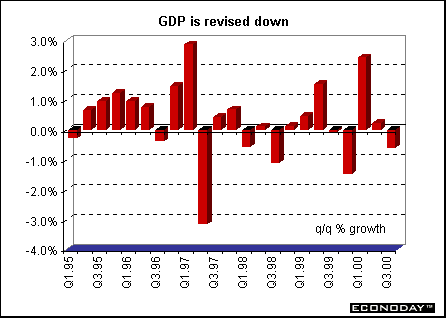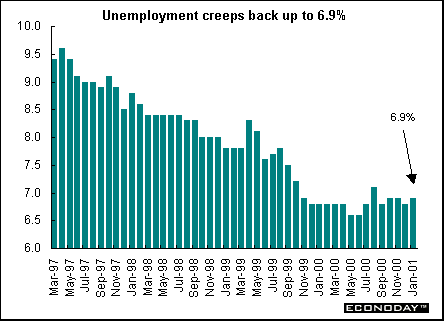
Indicator scoreboard
EMU - December industrial producer prices excluding construction fell 0.4 percent but rose 5.4 percent when compared with last year. The main factor behind the decline was a drop in intermediate goods prices. This category contains prices for oil and other commodities, which are strongly affected by exchange rate movements.

January seasonally adjusted Reuters services activity index fell to 55.2, the lowest level since May 1999. After reaching its peak of 62.2 in April 2000, the index has fallen in eight of the following nine months. However, the full point decline in services PMI this month is sharper than the half point decline in the manufacturing sector index that was released last week. An index reading above 50 signals that activity is expanding, a reading below 50 that it is contracting. The higher the reading above 50, the stronger the growth. The Reuters composite index for manufacturing and services output - combining data from the services survey and the Reuters euro-zone purchasing managers' index - fell to a seasonally adjusted 55.2 in January, its lowest level since May 1999.
November inflation, workday and seasonally adjusted retail sales rose 0.2 percent and 1.2 percent when compared with last year. Retail sales data are highly volatile and can be inconsistent because of the various methodologies used in different countries to calculate the data.

Germany - January seasonally adjusted pan-German unemployment rose 7000 because of worse than normal weather. In contrast to previous months, the rise in January seasonally adjusted unemployment was due entirely to conditions in west Germany, while east German joblessness remained stable. Despite the rise in the jobless level, the west German seasonally adjusted unemployment rate was unchanged at 7.3 percent, while that in the east was stable at 17.2 percent. The pan-German rate rose slightly to 9.3 percent from 9.2 percent. The headline unadjusted unemployment figures, which are the main numbers reported by the German press, rose sharply to 4.093 million in January from 3.809 million in December, with the unadjusted unemployment rate up to 10.0 percent from 9.3 percent.

December real seasonally adjusted manufacturing orders jumped rose 0.9 percent and 2.7 percent when compared with last year. Orders rose by 2.1 percent in west Germany and 12.1 percent in east Germany. Domestic orders rose 1.6 percent and foreign orders rose 4.0 percent. The December data are preliminary and may be revised.

December industrial production rose 0.7 percent and 5.8 percent from a year earlier. Manufacturing output rose by 0.8 percent, while output of capital goods such as machine tools and bulldozers fell 1.2 percent. Construction output was unchanged and mining output gained 0.8 percent. Production at utilities fell 2.3 percent. Seasonally and inflation adjusted production in west Germany rose 0.8 percent while output in the east fell 2.1 percent.

January final pan-German unadjusted consumer prices were unrevised, up 0.5 percent and up 2.4 percent when compared with last year. Excluding oil products, January CPI rose 2.2 percent on the year. Seasonally adjusted CPI rose 0.4 percent and 2.4 percent when compared with last year.
Italy - November industrial orders rose 5.3 percent on the year, after a 15.2 percent surge in October. Domestic orders climbed 2.0 percent while foreign orders jumped 10.2 percent. Recently introduced November seasonally adjusted orders fell 2.2 percent on the month. Domestic orders were down 4.8 percent but orders from abroad rose 1.5 percent.
Britain - January CIPS business activity index slipped to 57.1 from an unrevised 57.6 in December. The survey also showed that cost and price pressures weakened to reach the lowest inflation rates for over a year. Average rates charged by service providers rose at the slowest rate since October 1999.
January seasonally adjusted Halifax house price index rose 0.1 percent and 0.9 percent when compared with last year. The weak result contrasts sharply with the strong rises seen in the Nationwide survey, released last week, which showed a monthly rise of 2.5 percent and an annual rise of 11.2 percent.

December manufacturing output rose 0.3 percent and 1.6 percent when compared with last year. Industrial production, however, declined 0.6 percent but was up 0.5 percent on the year. The chief reason for the fall was a 6.9 percent monthly drop in the output of the electricity, gas and water industries, mostly due to milder weather in December.

Asia
Japan - December index of leading economic indicators rose to 50 percent, up from November's 30 percent reading. The leading index gauges economic activity in about six months. A reading of 50 percent means half the available components that make up the index improved compared to three months earlier, suggesting the economy will expand. Increases were registered in four of the eight available components - new car registrations, floor space of housing starts, money supply and job offers.
Third quarter gross domestic product was revised to a decline of 0.6 percent. The preliminary announcement in December was an increase of 0.2 percent. The last time that GDP declined was in the fourth quarter of 1999. The revisions indicate that corporate Japan is not making a significant contribution to getting the economy back on track. The third quarter GDP revision stemmed from weaker than estimated capital spending, which was reduced to an increase of 1.5 percent from the 7.8 percent gain initially reported.

January domestic wholesale prices dropped 0.3 percent when compared with last year. This was the fourth straight month of decline.
December seasonally adjusted private machinery orders, excluding shipbuilders and electric utilities, rose 3.8 percent and 13.5 percent when compared with last year.
Australia - January seasonally adjusted unemployment rate rose to 6.7 percent. Total employment slid by 3,500 jobs, but full time employment declined by 44,000 jobs, the third largest single month decline since the series began in 1978. The only time more full time jobs have been lost was in February and March 1991, when Australia was gripped by recession. Part time employment rose by 40,600 jobs. The participation rate slipped 0.1 percentage point to 63.5 percent.

Americas
Canada - January seasonally adjusted employment was virtually unchanged from December. As a result, the unemployment rate rose to 6.9 percent, up 0.1 percent from December. Job growth was equally split between full and part time work - a 20,000 gain in part time employment was offset by a similar decline in full time work. Manufacturing employment was little changed, after gains in the preceding three months.



Introduction • Global Stock Market Indexes • Recap of Global Markets • Currencies • Indicator Scoreboard

The Bottom Line • Looking Ahead
|